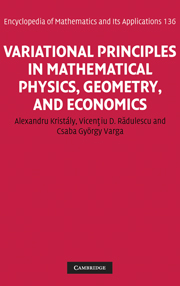 Variational Principles in Mathematical Physics, Geometry, and Economics
Variational Principles in Mathematical Physics, Geometry, and Economics Book contents
- Frontmatter
- Contents
- Foreword
- Preface
- Part I Variational principles in mathematical physics
- 1 Variational principles
- 2 Variational inequalities
- 3 Nonlinear eigenvalue problems
- 4 Elliptic systems of gradient type
- 5 Systems with arbitrary growth nonlinearities
- 6 Scalar field systems
- 7 Competition phenomena in Dirichlet problems
- 8 Problems to Part I
- Part II Variational principles in geometry
- Part III Variational principles in economics
- Appendix A Elements of convex analysis
- Appendix B Function spaces
- Appendix C Category and genus
- Appendix D Clarke and Degiovanni gradients
- Appendix E Elements of set-valued analysis
- References
- Notation index
- Subject index
3 - Nonlinear eigenvalue problems
from Part I - Variational principles in mathematical physics
Published online by Cambridge University Press: 05 June 2013
- Frontmatter
- Contents
- Foreword
- Preface
- Part I Variational principles in mathematical physics
- 1 Variational principles
- 2 Variational inequalities
- 3 Nonlinear eigenvalue problems
- 4 Elliptic systems of gradient type
- 5 Systems with arbitrary growth nonlinearities
- 6 Scalar field systems
- 7 Competition phenomena in Dirichlet problems
- 8 Problems to Part I
- Part II Variational principles in geometry
- Part III Variational principles in economics
- Appendix A Elements of convex analysis
- Appendix B Function spaces
- Appendix C Category and genus
- Appendix D Clarke and Degiovanni gradients
- Appendix E Elements of set-valued analysis
- References
- Notation index
- Subject index
Summary
All truths are easy to understand once they are discovered; the point is to discover them.
Galileo Galilei (1564–1642)The study of nonlinear eigenvalue problems for quasilinear operators on unbounded domains involving the p-Laplacian is motivated by various applications. We refer only to fluid mechanics, to mathematical models of the torsional creep, and to non-linear field equations arising in quantum mechanics. For instance, in fluid mechanics, the shear stress and the velocity gradient ∇pu of certain fluids obey a relation of the form (x) = a(x)∇pu(x), where ∇pu ≔∣u∣p−2∇u and p > 1 is an arbitrary real number. The case p = 2 (respectively, p < 2, p > 2) corresponds to a Newtonian (respectively, pseudo-plastic, dilatant) fluid. Then the resulting equations of motion involve div (a∇pu), which reduces to a∆pu = a div (∆pu), provided that a is a constant.
The p-Laplace operator also appears in the study of flows through porous media (p = 3/2, [209]) or glacial sliding (p ∈ (1, 4 /3], [176]). We refer to Aronsson and Janfalk [13] for the mathematical treatment of the Hele-Shaw flow of “power-law fluids.” The concept of Hele-Shaw flow corresponds to a flow between two closely spaced parallel plates, where the gap between the plates is small compared with the dimension of the plates.
- Type
- Chapter
- Information
- Variational Principles in Mathematical Physics, Geometry, and EconomicsQualitative Analysis of Nonlinear Equations and Unilateral Problems, pp. 81 - 116Publisher: Cambridge University PressPrint publication year: 2010


